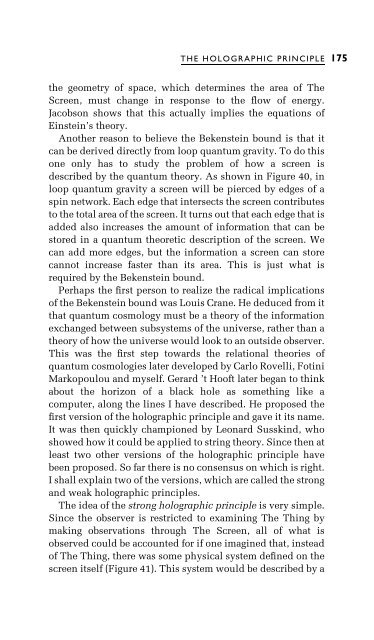Three Roads To Quantum Gravity
Three Roads To Quantum Gravity
Three Roads To Quantum Gravity
Create successful ePaper yourself
Turn your PDF publications into a flip-book with our unique Google optimized e-Paper software.
THE HOLOGRAPHIC PRINCIPLE<br />
175<br />
the geometry of space, which determines the area of The<br />
Screen, must change in response to the ¯ow of energy.<br />
Jacobson shows that this actually implies the equations of<br />
Einstein's theory.<br />
Another reason to believe the Bekenstein bound is that it<br />
can be derived directly from loop quantum gravity. <strong>To</strong> do this<br />
one only has to study the problem of how a screen is<br />
described by the quantum theory. As shown in Figure 40, in<br />
loop quantum gravity a screen will be pierced by edges of a<br />
spin network. Each edge that intersects the screen contributes<br />
to the total area of the screen. It turns out that each edge that is<br />
added also increases the amount of information that can be<br />
stored in a quantum theoretic description of the screen. We<br />
can add more edges, but the information a screen can store<br />
cannot increase faster than its area. This is just what is<br />
required by the Bekenstein bound.<br />
Perhaps the ®rst person to realize the radical implications<br />
of the Bekenstein bound was Louis Crane. He deduced from it<br />
that quantum cosmology must be a theory of the information<br />
exchanged between subsystems of the universe, rather than a<br />
theory of how the universe would look to an outside observer.<br />
This was the ®rst step towards the relational theories of<br />
quantum cosmologies later developed by Carlo Rovelli, Fotini<br />
Markopoulou and myself. Gerard 't Hooft later began to think<br />
about the horizon of a black hole as something like a<br />
computer, along the lines I have described. He proposed the<br />
®rst version of the holographic principle and gave it its name.<br />
It was then quickly championed by Leonard Susskind, who<br />
showed how it could be applied to string theory. Since then at<br />
least two other versions of the holographic principle have<br />
been proposed. So far there is no consensus on which is right.<br />
I shall explain two of the versions, which are called the strong<br />
and weak holographic principles.<br />
The idea of the strong holographic principle is very simple.<br />
Since the observer is restricted to examining The Thing by<br />
making observations through The Screen, all of what is<br />
observed could be accounted for if one imagined that, instead<br />
of The Thing, there was some physical system de®ned on the<br />
screen itself (Figure 41). This system would be described by a



![arXiv:1001.0993v1 [hep-ph] 6 Jan 2010](https://img.yumpu.com/51282177/1/190x245/arxiv10010993v1-hep-ph-6-jan-2010.jpg?quality=85)


![arXiv:1008.3907v2 [astro-ph.CO] 1 Nov 2011](https://img.yumpu.com/48909562/1/190x245/arxiv10083907v2-astro-phco-1-nov-2011.jpg?quality=85)








![arXiv:1002.4928v1 [gr-qc] 26 Feb 2010](https://img.yumpu.com/41209516/1/190x245/arxiv10024928v1-gr-qc-26-feb-2010.jpg?quality=85)
![arXiv:1206.2653v1 [astro-ph.CO] 12 Jun 2012](https://img.yumpu.com/39510078/1/190x245/arxiv12062653v1-astro-phco-12-jun-2012.jpg?quality=85)
